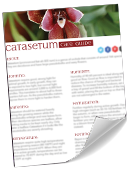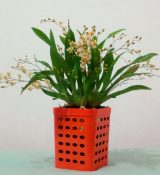Orchid Plant Pollination By Man – Part Two
Author: adminNo Comments
Blooming, Care and Culture, Classification, Growing Indoors, Growing Outdoors, Propagation
The paphiopedilum is difficult because the pollinia are in an awkward place behind the staminode and the stigmatic surface; the plate at an angle to the column with three lines radiating from it at an angle of 120 degrees is even more inaccessible.
One way out of the dilemmas of how to reach the stigmatic plate with the pollen, is to cut off the labellum at its base, but a better way is to employ a sharp safety razor blade and excise a little portion of the sole of the slipper, thus revealing the stigmatic surface. The matchstick is used gain to remove the pollinia; the flower to be fertilized is placed horizontally on the bench, with the pot wedged on each side, and the pollen is placed in the middle of the stigmatic plate where the lines converge.
The cymbidium is pollinated in a similar manner to the cattleya as are the miltonia, the odontoglossum and many other epephytal orchids.
After a period of months (see my post regarding Dendrobium nobile fertilization) which varies with the different genera, the pod is mature and the seed ready to be sown. If is has partially dehisced it is removed from the plant with a sharp knife and placed on clean paper for several days to allow the dehiscing to continue. The seed pod is then tapped gently to empty the pod, and the paper is then folded until sowing time. The pod must be kept in a cool dry atmosphere; the humid conditions in a greenhouse are likely to cause fungus or mold infections and the seed rendered useless.
Check out Orchid Plant Pollination By Man – Part One post, for more information and examples on pollinating orchid plants by man! Also be sure to take a look at my Sowing The Orchid Seed post!


Ask an Expert
Questions about orchids?
Our experts love a challenge!
Photo of the Week
Submit your photo to be featured on the blog!
More Photo of the Week Winners
Submit Photo







